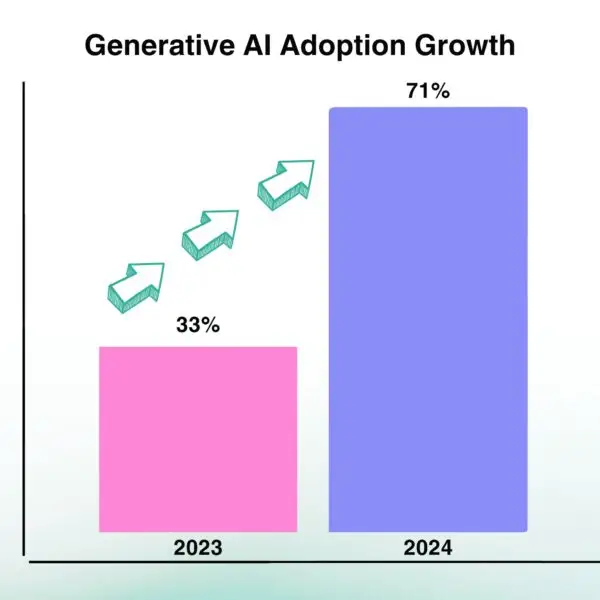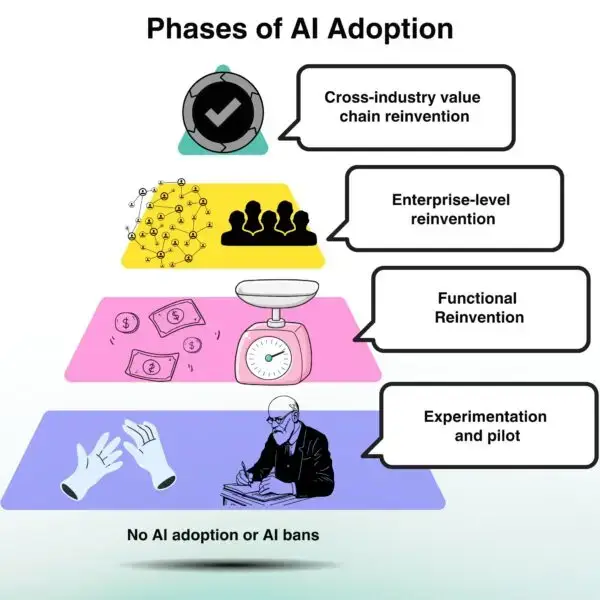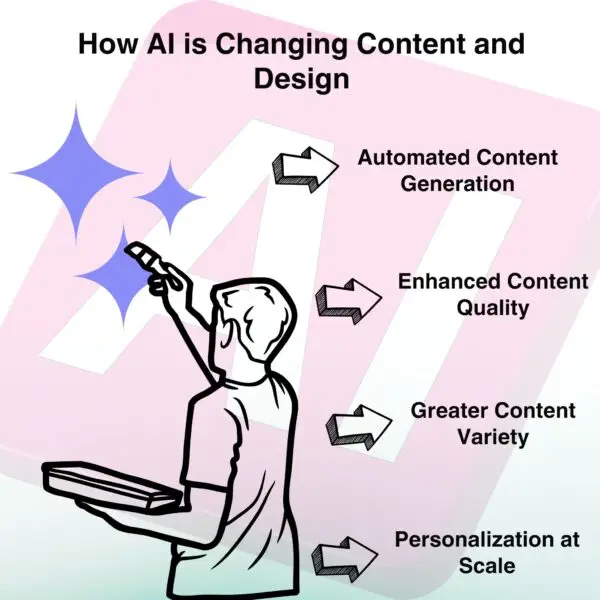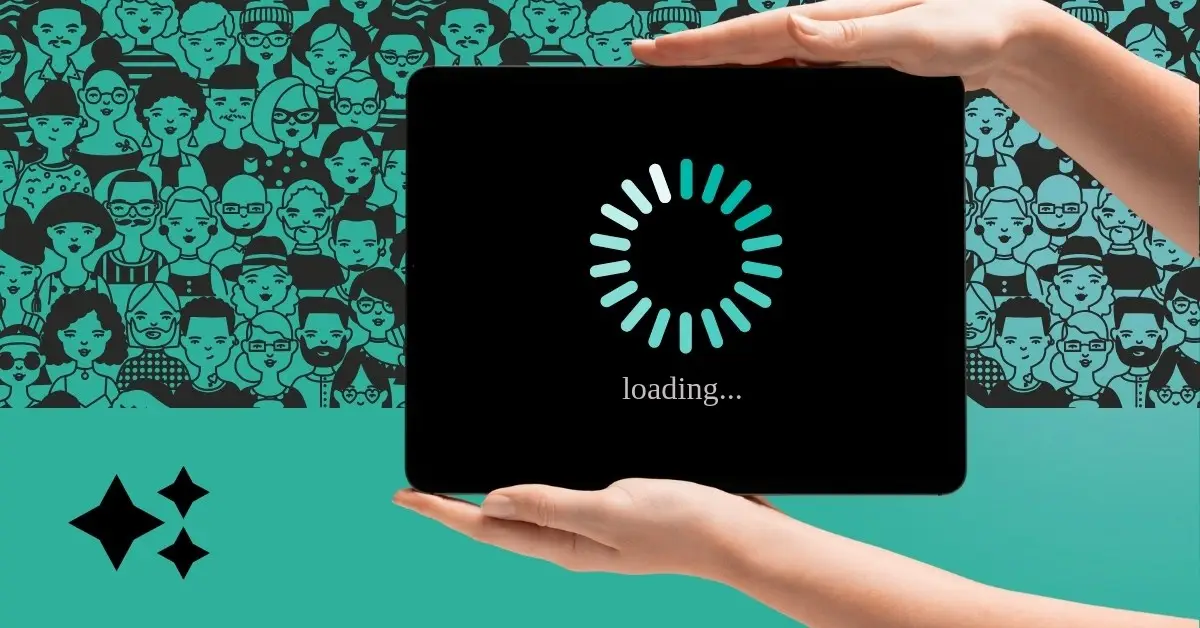Why AI Tools for Marketing Agency Matter More Than Ever… In 2025, the marketing agency landscape isn’t just adopting artificial intelligence (AI)—it’s being transformed by it.
According to recent research, 88% of marketers now use AI tools daily, and 83% of companies rank AI among their top business priorities. But with this wave of adoption comes a fundamental question: Which AI tools actually drive real ROI for agencies and their clients?
As someone who has helped agencies transition from manual to AI-powered workflows, I’ve seen firsthand that the agencies excelling today are the ones that not only integrate AI, but also rigorously measure its impact.
In this comprehensive guide, we’ll explore the essential AI tools for marketing agency growth in 2025, how to measure their ROI, and the strategies leading agencies are using to future-proof their businesses.
The AI Tipping Point: Why 2025 Is Different
The explosion of generative AI adoption—from 33% in 2023 to 71% in 2024—means that AI is now embedded in every aspect of agency operations: campaign ideation, content creation, client reporting, and optimization.

Why it matters:
AI is now embedded in every agency workflow—from campaign ideation, to client reporting, to optimization and measurement. The new question is not “should we use AI tools for marketing agency tasks?” It’s “how do we measure which AI tools move the needle for our clients, our team, and our bottom line?”
But while adoption is surging and it clearly “matters”, not all organizations are at the same point on their AI journey. According to the World Economic Forum, most companies are still in the early phases, with only a minority reaching true enterprise-level reinvention. Understanding where your agency sits on this curve is key to maximizing the value of AI Tools for Marketing Agency teams in 2025.
Phases of AI-Driven Reinvention in Consumer Industries
The journey toward AI maturity in consumer industries is not a single leap, but a staged evolution. The table below—drawn from World Economic Forum research—shows how companies are distributed across five distinct phases of AI adoption and reinvention as of 2024. Each phase has unique challenges, opportunities, and implications for agency leaders and brand strategists.
| Phase | Description | % of Companies (2024) | Phase Summary |
|---|---|---|---|
| Phase 0 | No AI adoption, or AI bans | 10-15% (Laggards) | Organizations have not begun their AI journey, often due to regulatory constraints, risk aversion, or a lack of awareness of AI’s potential. |
| Phase 1 | Experimentation and pilot | — (Individual teams) | Companies are running multiple AI experiments, typically disconnected from core business strategy and driven by individual teams or tech-savvy leaders. |
| Phase 2 | Functional reinvention | 70% (Transformers) | The majority are here: measurable value is being realized by deploying AI at scale within specific domains (e.g., marketing, supply chain, or customer service). |
| Phase 3 | Enterprise-level reinvention | 10-15% (Leaders) | A minority are integrating AI across multiple functions, enabled by robust data infrastructure, governance, and upskilling. This unlocks enterprise-wide synergies. |
| Phase 4 | Cross-industry value chain reinvention (not yet achieved) | 0% | The frontier: AI initiatives extend across the entire value chain and ecosystem, including innovative collaborations with suppliers, partners, and even competitors. |
What Does This Mean for AI Tools for Marketing Agency?
- Most organizations are still early in their AI journey. With 70% in “functional reinvention,” true enterprise-wide transformation is rare—but those who reach it are poised to lead.
- Laggards risk falling behind. Companies stuck in Phase 0 or Phase 1 may soon face competitive disadvantages, especially as AI-driven efficiency and personalization set new industry standards.
- Fragmentation is common in early phases. Experimentation (Phase 1) is important, but without a unified strategy, it rarely delivers sustainable ROI or business impact.
- Enterprise-level reinvention (Phase 3) is a game changer. Agencies and brands that make the leap to connected, cross-functional AI strategies gain outsized benefits: cost reduction, innovation speed, and better customer experiences.
- Nobody is “done” with AI. Even leaders have not yet achieved cross-industry, ecosystem-wide transformation—meaning the playing field remains dynamic and opportunities abound for those who act decisively.
How to Advance on the AI Adoption Curve
- Build foundational data infrastructure and governance. This is essential for scaling from functional pilots to enterprise-wide AI.
- Invest in workforce upskilling and change management. Human expertise remains critical for AI success at every stage.
- Align AI initiatives with core business strategy. The move from scattered pilots to unified transformation requires executive sponsorship and clear objectives.
- Seek collaborative advantage. Future leaders will look beyond the organization to partnerships and ecosystem innovation.
For a practical roadmap and real-world examples, check out this step-by-step Mastering AI Adoption Guide.
In summary, while AI adoption is quickly accelerating, most agencies and consumer brands are still progressing through the foundational and functional phases. The opportunity for competitive advantage is greatest for those who can move beyond pilots and integrate AI into enterprise-wide strategies and creative processes.

What ROI Really Means in the Age of AI
Traditionally, agencies measured ROI by campaign results, cost-per-acquisition, and time to market. AI fundamentally changes this equation. Today, ROI from AI Tools for Marketing Agency work includes:
- Time Saved: Automation eliminates hours of manual work.
- Accuracy & Insight: Machine learning uncovers deeper, more reliable insights.
- Scalability: Agencies can handle more clients without proportional increases in staff.
- Quality & Consistency: AI ensures messaging and brand voice stay on point, every time.
But the true business impact of AI is still being defined. Recent analyses from leading financial institutions and economists show a wide range of projected benefits, highlighting both the potential and the uncertainty surrounding AI-driven ROI.
As it is stated above in the Phases of AI Adoption section, most companies are probably still in the second phase trying to figure out a balance between profiting from AI and learning exactly how much money they should spend on it. Adopting AI Tools for Marketing Agency use is too a process, but thankfully, there are a lot of studies, use cases, and reports already available to the public, so the journey should feel less dark or scary.
Projected Business Impact of AI (2025 and Beyond)
| Source | Projected Global GDP Boost from AI | Perspective |
|---|---|---|
| Goldman Sachs | 15% over the next decade | Highly optimistic, transformative potential |
| J.P. Morgan | 8–9% over the next decade | Positive, but more restrained |
| Daron Acemoğlu (MIT) | 1–1.5% (cautious estimate) | Skeptical, warns of slower or limited gains |
| Coherent Solutions (2025 AI Trends Report) | Still in early adoption; value varies | Focus on incremental and foundational improvements |
Table adapted from Coherent Solutions.
Expert Quote:
“Prepare for future transformation: With generative and agentic AI advancing rapidly, agencies should prepare for even greater changes in creative processes, client strategies, and operational efficiency.”
— Tim Donovan, Agency Consultant
The current consensus? Most value today comes from getting the basics right. Agencies are more likely to realize ROI from AI if they:
- Reduce operational costs
- Drive business growth
- Differentiate customer experience
- Ensure secure and reliable operations
No matter which estimate proves correct, the key is to align your AI investments with tangible goals—improving efficiency, deepening insight, and future-proofing your agency’s relevance and results.
Top AI Tools for Marketing Agency Teams in 2025
Here are the must-know AI platforms that forward-thinking agencies are using to gain a competitive edge:
1. Aurora
Best for: Workflow automation, knowledge management, and team collaboration
- Centralizes documentation, assets, and processes in one AI-powered platform.
- SmartFlows automate repetitive tasks, freeing up creative and strategic bandwidth.
- Used by agencies like 500 Designs to achieve 40% revenue growth and double project capacity—without increasing headcount.
2. Jasper
Best for: AI copywriting and content creation
- Generates high-converting ad copy, SEO blog posts, and even email campaigns.
- Agencies report a 30–50% reduction in content turnaround time.
3. HubSpot
Best for: Marketing automation and CRM
- AI-driven lead scoring, predictive analytics, and omnichannel automation.
- Seamless integration with sales and customer service pipelines.
4. SEMrush & SurferSEO
Best for: SEO optimization and real-time content scoring
- AI-enhanced keyword research, on-page optimization, and competitive analysis.
- SurferSEO’s content scoring is now integrated with many leading generative AI tools.
Most of these platforms are consistently featured in industry roundups and “top tool” lists online and Reddit threads.
Watch this Business Solution Video below to learn about AI Marketing Tools by Categories and Use Cases:
Measuring and Communicating ROI; Tools for Marketing Agency
Implementing AI is just the beginning. Real success comes from knowing how to measure and communicate its value—internally and to clients.
Key Metrics:
- Time Saved: Quantify hours saved by automation.
- Campaign Performance: Track improvements in CTR, conversion rate, and cost per lead.
- Client Satisfaction: Survey clients on reporting speed and campaign outcomes.
- Team Productivity: Measure reduction in manual tasks and errors.
- Better Strategy: And this one could be argued but “75% of companies who use AI for marketing are expected to shift to more strategic activities”.
When it comes to how to communicate this new type of ROI when implementing AI Tools for Marketing Agency Use; we would recommend it’s best you let your clients know when you’ll be utilizing AI-support during onboarding. Just like you would introduce your entire team, you can casually mention which members will be enhancing their work with the latest technology in the industry. You could also do some research on your competitors’ websites and mention how they are too including AI use to match the industry’s expectations.
And later you could follow up by creating dashboards for them to showcase how the use of these allowed for your team to be able to spend more time in other requests, in creative sessions, or in strategy itself.
The Why Behind Measuring ROI of AI Tools for Marketing Agency Teams
1. Accountability in a Data-Saturated World
AI enables agencies to do more, faster. But with this power comes a greater need for transparency. Leadership and clients want to know:
- Which tools are essential, and which are “shiny objects”?
- Are we seeing measurable improvement in campaign outcomes, not just activity?
Why:
Measuring ROI ensures you’re investing in tools that make a real difference—and cutting those that don’t.
2. Competitive Differentiation
With AI tools for marketing agencies becoming ubiquitous, demonstrating ROI helps your agency stand out.
- Can you quantify how much faster you deliver?
- Can you show clients how AI improves targeting or lowers cost per lead?
Why:
Proof beats hype. In a crowded agency market, those who document and share real ROI win trust and new business.
3. Continuous Improvement
AI evolves rapidly. Measuring ROI helps agencies:
- Identify what’s working (and double down)
- Spot gaps or redundancies in their AI stack
- Justify new investments to stakeholders
Why:
ROI measurement isn’t a one-off report—it’s a feedback loop for smarter, more agile agency operations.
Enterprise vs. Small Agency: Right Stack, Right Results
Small Agency Case Study: Flux Branding × Aurora
Flux Branding, a Los Angeles-based creative agency, needed a secure, scalable way to manage complex client projects without sacrificing confidentiality or creative consistency. With Aurora, they reduced delivery times from days to hours, won high-value contracts, and empowered every team member to work at their creative best.
Key Outcomes for Flux Branding:
| Metric | Result |
|---|---|
| Project Turnaround Time | 80% decrease (from days to hours) |
| Contracts Won | $90,000+ |
| Team Impact | Empowered, collaborative, and creative |
| Security & Confidentiality | Private knowledge bases for each client |
| Operational Scale | 38 project descriptions done in hours |
Client Quote:
“What I really like about Aurora is the fact that it has private knowledge bases where I could put in information that might be considered confidential and not share it with a larger language model.”
— Jamie Schwartzman, Founder & CEO, Flux Branding
Learn more about How Flux Branding Accelerated Creative Excellence with Aurora.
Enterprise Case Study: L’Oréal & AI-Powered Personalization
L’Oréal, a global beauty enterprise, uses AI and generative AI to deliver hyper-personalized, data-driven customer experiences at scale. Their innovations include digital twins (“synthetic consumers”) for market testing, AI-powered assistants, smart diagnostic tools, and augmented products—enabling the company to shift from “beauty for all” to “beauty for each.” This transformation is helping L’Oréal anticipate customer needs, speed innovation, and launch new products and digital services faster than ever.
| Metric/Initiative | Result/Description |
|---|---|
| AI in Marketing | Synthetic consumers/digital twins used for rapid market testing and proposition development |
| Personalization | AI connects personally with customers, shifting focus to “beauty for each” |
| Innovation | AI-powered assistants, diagnostic tools, and devices for salon-quality results at home |
| Agility | Faster development and delivery of new products, apps, and customer experiences |
| Ecosystem Collaboration | Partnerships across the value chain—suppliers, partners, and even competitors |
Comparison Table: Small Agency vs. Enterprise AI Stack
| Feature/Outcome | Small Agency (Flux Branding) | Enterprise (L’Oréal) |
|---|---|---|
| Primary Need | Secure, creative project management & rapid delivery | Hyper-personalized, scalable customer engagement |
| AI Solution | Aurora: private knowledge bases, cloud workspaces | In-house + partner AI: digital twins, assistants, apps |
| Turnaround Time | Reduced by 80% | Rapid market testing, faster product launches |
| Team Impact | Empowered, collaborative, creative | Cross-functional, ecosystem-wide alignment |
| Confidentiality | High (client-specific silos) | High (sensitive R&D, consumer data) |
| Business Value | Won high-value contracts, scaled output | Reinvented customer experience, competitive advantage |
| Tech Stack | Cloud-native, modular, low-maintenance | AI/ML, big data, smart devices, AR/VR, mobile, ecosystem |
Whether you’re a boutique agency or a global enterprise, the right AI stack delivers measurable ROI—but the path and priorities differ. Small teams thrive with secure, modular, and collaborative tools like Aurora, while enterprises leverage large-scale AI platforms to drive personalized, end-to-end customer experiences and innovation.
The Creative Side And How AI Is Changing It
In recent years, the conversation around AI in marketing has shifted from productivity gains to its transformative impact on creativity itself. According to Harvard Business Review, generative AI is no longer just a tool for automating routine tasks—it is actively reshaping how creative work is done, enabling marketers to experiment with ideas, formats, and media at a scale and speed that was previously impossible. This shift is empowering both large agencies and small teams to unlock new forms of creative expression, regardless of their previous technical expertise.
AI isn’t just about efficiency. Leading agencies are using AI for brainstorming, visual generation, and even campaign concepting and presentation creation. Tools like Midjourney, DALL-E, and Canva’s AI design suite are letting small teams punch above their weight creatively.
Harvard Business Review highlights several key ways that AI is transforming creative industries:
- Automated Content Generation:
AI models trained on massive datasets can now draft articles, blogs, or social media posts in seconds, giving content creators a powerful ally for ideation and first drafts. This not only saves significant time but also helps overcome creative blocks by providing a range of starting points. - Enhanced Content Quality:
Thanks to their exposure to vast quantities of information, AI systems can recognize patterns, trends, and stylistic nuances that even experienced professionals might miss. As a result, AI-generated drafts often surface fresh angles, improve clarity, and ensure consistency across large volumes of content. - Greater Content Variety:
Generative AI isn’t limited to text—it can also create images, video, and audio, allowing marketers to diversify their content mix. This flexibility helps brands reach wider audiences by tailoring creative assets to different platforms and preferences. - Personalization at Scale:
AI can analyze user data and generate content that’s tailored to individual interests, making it easier for marketers to deliver targeted campaigns that resonate with specific segments. This personalization increases the likelihood of engagement and sharing. Learn more about Ways AI Tools for Agencies Empower Personalization at Scale.
In summary, Harvard’s analysis underscores that the true promise of generative AI lies in its ability to augment human creativity, not replace it. Agencies leveraging these innovations are finding new ways to ideate, design, and connect with audiences—unlocking a level of creative agility that sets them apart in a rapidly evolving digital landscape.

Conclusion: Future-Proofing Your Agency
In 2025, the real question is no longer “Should we use AI Tools for Marketing Agency growth?” but rather, “How do we maximize, measure, and consistently communicate the value these tools deliver?” Agencies that thrive in this new landscape will be those that embrace change, invest in learning, and keep their focus on outcomes that matter most to their clients.
The most successful marketing agencies will:
- Adopt scalable, flexible AI Tools for Marketing Agency workflows that can evolve as technology and client needs change.
- Measure what matters—speed, campaign performance, client satisfaction, and productivity—and use these insights to refine strategies and justify investments.
- Clearly communicate ROI to both clients and internal stakeholders, building trust and demonstrating expertise in the AI-powered marketing space.
- Continuously optimize for both traditional and AI-powered search, ensuring your agency’s content remains visible, relevant, and competitive as search algorithms evolve.
No matter your agency’s size or specialization, understanding and acting on the “why” behind your AI Tools for Marketing Agency investments is the key to long-term, differentiated growth. The agencies that lead tomorrow will be those who use AI not just as a tool, but as a catalyst for creativity, efficiency, and measurable impact.
Ready to future-proof your agency? Start evaluating, integrating, and iterating with AI Tools for Marketing Agency today—because the future is already here.
Frequently Asked Questions (FAQs)
What are the best AI tools for marketing agency use in 2025?
A: Tools that deliver measurable ROI, automation, and client value. Leaders include Aurora, Jasper, HubSpot, SEMrush, and SurferSEO.
What is Aurora, and how does it help marketing agencies?
A: Aurora is an AI-powered platform designed to centralize agency knowledge, automate workflows, and enhance team collaboration. Agencies use Aurora to reduce project turnaround times, streamline content creation, and securely manage both client and internal information—all in one cloud workspace.
How does Aurora improve the presentation creation process?
A: Aurora integrates with Liquid Docs, an AI-driven presentation tool that automatically transforms unstructured information—like meeting notes or draft documents—into polished, visually engaging decks. With features like dynamic storytelling, designer templates, and conversational editing, Aurora and Liquid Docs empower anyone to create high-quality presentations in minutes, with no design skills required.
What makes Liquid Docs different from standard slide tools?
A: Liquid Docs uses proprietary AI to organize, prioritize, and visualize your information. It offers adaptive layouts, real-time AI chat editing, and instant sharing—all while keeping your content secure and on-brand. It’s built for fast, easy, and effective storytelling, no matter your role or design experience.
Who can benefit from using Aurora and Liquid Docs?
A: Both tools are designed for marketing agencies, project managers, sales teams, and client services professionals—anyone who needs to turn messy, everyday information into clear, actionable, and beautiful presentations or knowledge assets. Agencies of all sizes use Aurora and Liquid Docs to save time, improve output quality, and win more business.
Why should agencies measure the ROI of AI tools?
A: To ensure tech investments actually drive results and competitive differentiation.
How can agencies optimize their sites for AI search results?
A: Use clear headings, structured data, up-to-date content, and answer client questions directly.
Want to try Aurora for your agency? Sign up for free here.
